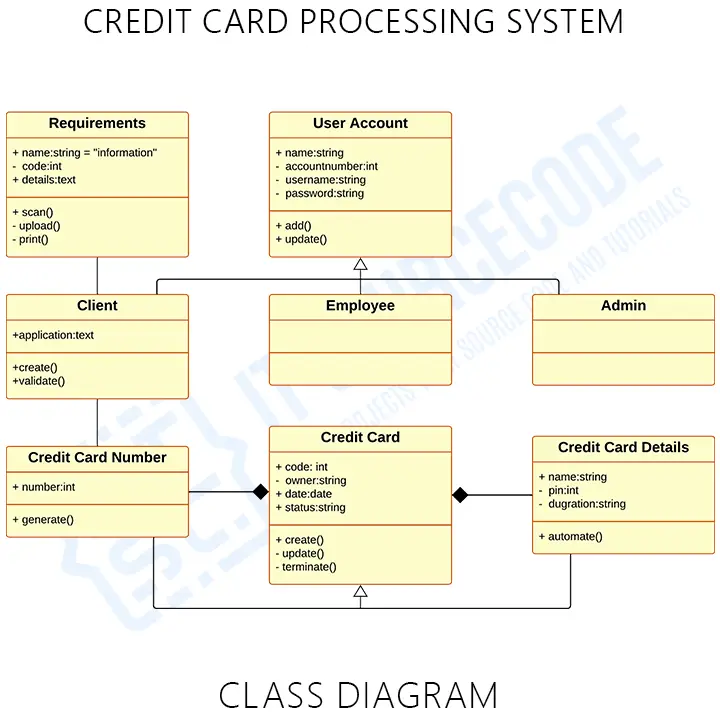A Credit Card Processing System Class Diagram is used to represent, explain, and document the parts (classes) of an credit card processing system. It can also be a reference or way to create executable software code.
Class diagrams provide an overview of the system’s classes, functions, and relationships.
Project Overview
| Name: | Credit Card Processing System Class Diagram |
| UML Diagram: | Class Diagram |
| User: | Credit Card Applicants or Holder, Lending Companies, and Banks. |
| Tools Used: | Lucidchart.com was used to create the diagrams but you may use other diagram tools. |
What is a Credit Card Processing System?
A software that provides aid in a complicated business with many moving pieces is credit card processing software. It is a multi-step process that correctly completes credit card payments.
Moreover, the software applies new technology, payment networks, regulatory authorities, and financial institutions. Credit card processors, like any service involving that level of sophistication, also vary in quality.
UML Class Diagram for Credit Card Processing System
The UML class diagram is similar to a flowchart, but classes are present in boxes with three rows inside. The top rectangle holds the class’s name; the middle rectangle contains the class’s properties, and the bottom row contains the class’s operation (methods).
The class diagram is one of the most useful forms of UML diagrams because it elaborates the system’s structure by representing its classes, characteristics, processes, and object relationships.
Credit Card Processing System Class Diagram
This simple class diagram gives you the exact details about the system’s class characteristics and methods. It also clarifies the connections of classes in the system.
Here, I will be showing you the sample constructed class diagram provided with its attributes and methods. This is from the simple idea of the credit card processing system’s common function.

The illustration shows a simple idea of how the class diagram works. It resembles a flowchart in which classes are present in boxes with three rectangles in each. The top rectangle has the class’s name; the middle holds the class’s properties, and the bottom contains the class’s methods.
The classes identified for the credit card processing system were the requirements, user account, client, employee, admin, credit card number, credit card, and credit card details. Their roles are in the middle part and called their attributes. The function of each class is in its’ methods.
You can edit this diagram and it is up to you how will you create your class diagram. However, you need to be precise with your information and consider the decisions included.
Downloadable Pdf File
How to Draw a Class Diagram?
Time needed: 1 minute
Steps in creating Class Diagram for Credit Card Processing System.
- Step 1: Familiarize Class Diagram Components
Class Diagram Components are used to create class diagrams. Each of the symbols has a primary role in building the class diagram.
To plot the class diagram you will need the class name, its attributes, methods, and their access (visibility). You will base the diagram on the evaluated information to have the exact Class Diagram. - Step 2: Determine the targeted users
Classes are the main part of the diagram and it is presented in a box with three main partitions. It should be declared properly because it could be converted to codes.
- Step 3: Analyze the activities included
Attributes of a class should be placed in the middle part of a class. They were then assigned visibility symbols. This visibility has something to do with the codes.
The operations will be placed at the bottom of a class and represent the functions of a class within a system. - Step 4: Plot the Class Diagram
To map the relationship between the classes, you also need to know the meaning of the symbols at the end of each line that connects them. The ends represent different meanings and relations between two or more classes.
Conclusion
The class diagram is a modeled diagram that explains systems classes and relationships. It can depict the names and attributes of classes, as well as their links and methods that make up the software.
Moreover, the class diagram is the most essential type of UML diagram and is critical in software development. It is an approach to showing the system’s structure in detail and part by part.
Related Article:
- Credit Card Processing System UML Diagrams
- Deployment Diagram for Credit Card Processing System
- Component Diagram for Credit Card Processing System
- Activity Diagram for Credit Card Processing System
- Credit Card Processing Sequence Diagram
- Class Diagram for Order Processing System
- Use Case Diagram for Credit Card Processing System
Inquiries:
If you have inquiries or suggestions about the Class Diagram discussion, leave us your comments below. We would be glad to hear to concerns and be part of your learning.

